Puppis is a constellation located in the southern hemisphere. It represents the stern of a ship, as it was once part of a larger constellation named the Argo Navis, which represented the mythical Argonauts.
Key Facts & Summary
- The Constellation of Puppis is the 20th largest constellation in the sky, stretching for around 673 square degrees. It is part of the 88 modern constellations.
- The constellation of Puppis was once part of the gigantic Argo Navis constellation, which was later split into three smaller constellations, namely Puppis, Carina, and Vela.
- The Argo Navis constellation was part of the 48 Greek constellations, listed by the famous astronomer Ptolemy, in his 2nd century Almagest.
- The constellation of Argo Navis was later divided by Nicolas Louis Lacaille, in 1752.
- The brightest star in the constellation of Puppis is Naos / Zeta Puppis, which has an apparent magnitude of 2.25. It is the only star brighter than magnitude 3 in this constellation.
- Currently, around 6 stars in the constellation of Puppis have been confirmed to host exoplanets.
- There are 3 Messier Objects located in the constellation of Puppis, namely the Messier 46, Messier 47, and Messier 93 open clusters.
- Since an important part of the Milky Way runs through the constellation of Puppis, the constellation hosts many interesting deep-sky objects, such as open clusters, planetary nebulae, or globular clusters.
- Some notable stars in Puppis, apart from Naos, is Tureis, Asmidiske, HD 70642, HD 69830, HD 60532, Pi Puppis, Tau Puppis, Nu Puppis, HD 64760, NS Puppis, L2 Puppis, HD 68601, or NGC 2423-3, among many others.
- Some of the notable deep-sky objects in Puppis are the Skull and Crossbones Nebula, NGC 2451, NGC 2477, Collinder 135, NGC 2438, NGC 2509, NGC 2439, NGC 2438, NGC 2440, NGC 2298, NGC 2546, or the Calabash Nebula, among others.
Puppis Constellation
The constellation of Puppis is a southern constellation, that was once part of the great Argo Navis constellation, during Ptolemy’s era, as it was listed in the astronomer’s star catalog, named the Almagest, in the 2nd century.

The Argo Navis represented the ship on which the famous Greek hero, Jason, and the Argonauts sailed to get the Golden Fleece. The constellation of Argo Navis was later divided by Nicolaus Louis de Lacaille, into three smaller constellations.
This happened in 1752, and the Argo Navis was split into Puppis, which represented the stern of the ship, Carina, which represented the keel, and Vela, which represented the sails.

Location
The constellation of Puppis is located in the southern celestial hemisphere, being the 20th largest constellation in the sky, out of the 88 modern constellations. Puppis stretches for around 673 square degrees.
The constellation of Puppis is situated in the second quadrant of the southern hemisphere (SQ2), and it can be seen at latitudes between +40o and -90o. The best time of the year to observe the stars and deep-sky objects in Puppis is during the month of February when the constellation is the most prominent.
- Right Ascension: 7.5h
- Declination: -30o
- Visible: between +40o and -90o
- Best Viewed: at 21:00 (9 p.m.) during February

The constellation of Puppis is bordered by the constellations of Carina, Canis Major, Columba, Hydra, Monoceros, Pictor, Pyxis, and Vela.
The constellation of Puppis is part of the Heavenly Waters family of constellations, along with Carina, Columba, Delphinus, Equuleus, Eridanus, Piscis Austrinus, Pyxis, and Vela.
Messier Objects Located in the Constellation of Puppis
There are 3 Messier Objects located in the constellation of Puppis, namely the Messier 46, Messier 47, and Messier 93 open clusters.
Messier 46
Messier 46, also designated as NGC 2437, is an open cluster that was discovered in 1771 by famous astronomer Charles Messier. This cluster has an apparent magnitude of 6.1, and it is located at around 4,920 light-years away from us.
Messier 46 contains around 500 stars, as it has a radius of around 37.8 light-years, while its core stretches for around 8.5 light-years. It is around 251.2 million years old.

Around the northern edge of Messier 46, lies the NGC 2438 planetary nebula, while the illuminating star of the bipolar Calabash Nebula, shares the radial velocity and proper motion of Messier 46. The bright star in the Calabash Nebula is also located at the same distance from us, as Messier 46, and thus it is classified as a bonafide member of the open cluster. Messier 46 is also very close to another famous open cluster, namely Messier 47.
Messier 47
Messier 47, also designated as NGC 2422, is an open cluster that was discovered before 1654, by Giovanni Batista Hodierna. It is located at around 1,600 light-years from us, and it has an apparent magnitude of 4.2.
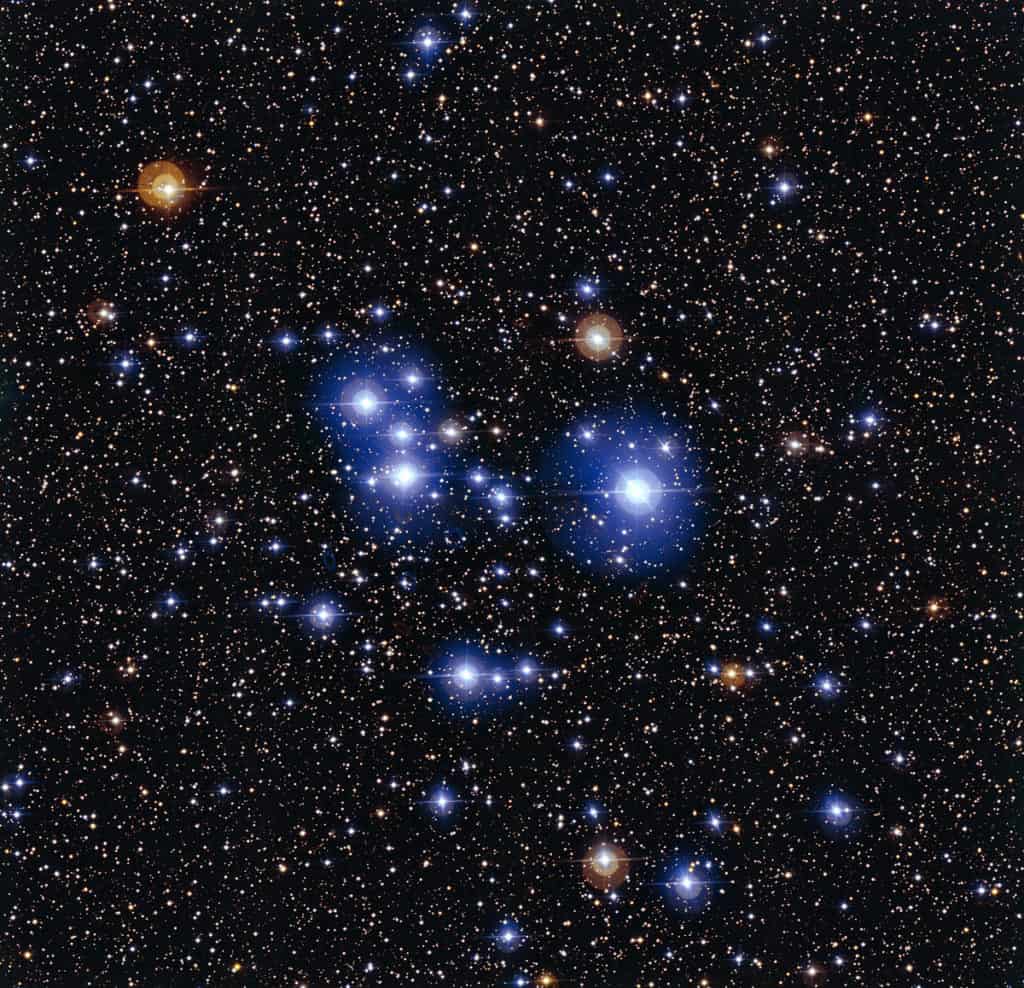
Messier 47 is 78 million years old, and it also contains around 500 stars, most of them being red dwarfs. This open cluster is located at almost one degree away from Messier 46.
Messier 93
Messier 93, also designated as NGC 2447, is an open cluster that was discovered by Charles Messier in 1781. It is located at around 3,380 light-years away from us, and it has an apparent magnitude of 6.2.

Messier 93 has a spatial radius of around 5 light-years, a tidal radius of 13.1 light-years, and a core radius of 4.2 light-years. This cluster is 387.3 million years old, and it contains many bright, and variable stars.
Notable Stars in the Constellation of Puppis
The constellation of Puppis contains several interesting stars, such as Naos, Tureis, Asmidiske, HD 70642, HD 69830, HD 60532, Pi Puppis, Tau Puppis, Nu Puppis, HD 64760, NS Puppis, L2 Puppis, HD 68601, or NGC 2423-3, among many others.

The brightest star in the constellation of Puppis is Naos / Zeta Puppis, which has an apparent magnitude of 2.25. It is the only star brighter than magnitude 3 in this constellation Currently, around 6 stars in the constellation of Puppis have been confirmed to host exoplanets.
Naos
Naos, designated as Zeta Puppis, is the brightest star in the constellation of Puppis, and among the hottest, and most luminous stars visible to the naked eye, being the 72nd brightest star in the sky.
Naos has an apparent magnitude of 2.25, and it is located at around 1080 light-years away from us. This star is very young, being only 3.2 million years old.

Naos is an O-type star, one of the closest of its class to Earth. Its stellar wind is extremely strong, measured at 2,500 km / 1,553 mi per second.
This star has around 5,610% of our Sun’s mass, 2,600% of its radius, and its bolometric luminosity is 813,000 times greater than our Sun’s, being more than 10,000 times brighter.
Naos is more than 50 times bigger than our Sun, and it is 6.9 times hotter, with temperatures reaching 40,000 K. Naos is also a fast-spinning star, having a rotational velocity of 220 km / 136.7 mi per second.

Tureis
Tureis, designated as Rho Puppis, is the prototype of the Puppis class of evolved Am stars. It is located at around 63.5 light-years away from our Solar System, and it has an apparent magnitude of 2.78.
Tureis is an F-type Am star, having weak lines of calcium and strong lines of other metals in its spectrum, and it is surrounded by a circumstellar disk of dust that extends for around 50 AU from the star.

Tureis has around 185% of our Sun’s mass, 341% of its radius, and it is 22 times brighter than our Sun. This star is also hotter, having temperatures of around 6,920 K.
Asmidiske
Asmidiske, designated as Xi Puppis, and otherwise known as Azmidi, is a multiple star system located at around 1,200 light-years away from us, and it has a combined apparent magnitude of 3.35.

The brightest star in this system is a G-type giant star, that has around 990% of our Sun’s mass, and it is 60,000 times brighter than our Sun. Asmidiske is cooler than our Sun, with temperatures reaching only 4,880 K.
HD 70642
HD 70642 is a yellow dwarf star located at around 92 light-years away from us. It has an apparent magnitude of +7.18, and it also hosts an exoplanet.

The planet was discovered in 2003, and it is located at around 3 AU from the star. The habitable zone of HD 70642 is exactly like our Sun’s (1 AU), and the star is also similar to it from other perspectives as well. This planetary system is among the most similar to our own.
HD 69830
HD 69830, also known as 285 G. Puppis, is a yellow dwarf star located at around 41 light-years away from us. It has an apparent magnitude of +5.98, and it hosts three exoplanets and an asteroid belt-like system.
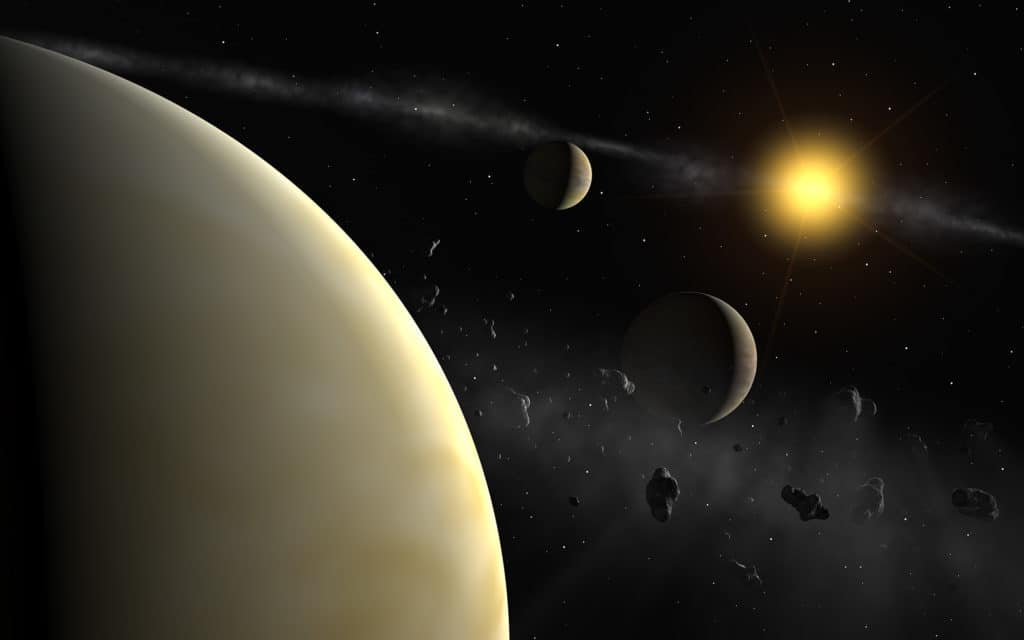
This star is very similar to our Sun. The asteroid belt in this system contains much more dust than our own. The three exoplanets are similar to the planets Uranus or Neptune.
HD 60532
HD 60532 is a white F-type main-sequence star located at around 83.8 light-years away from us. It has an apparent magnitude of 4.450, and it hosts two exoplanets similar to Jupiter.
The star has around 144% of our Sun’s mass, 252% of its radius, and it is 8.5 times brighter than our Sun, and it is similarly as hot as our Sun, with temperatures reaching 6,095 K.
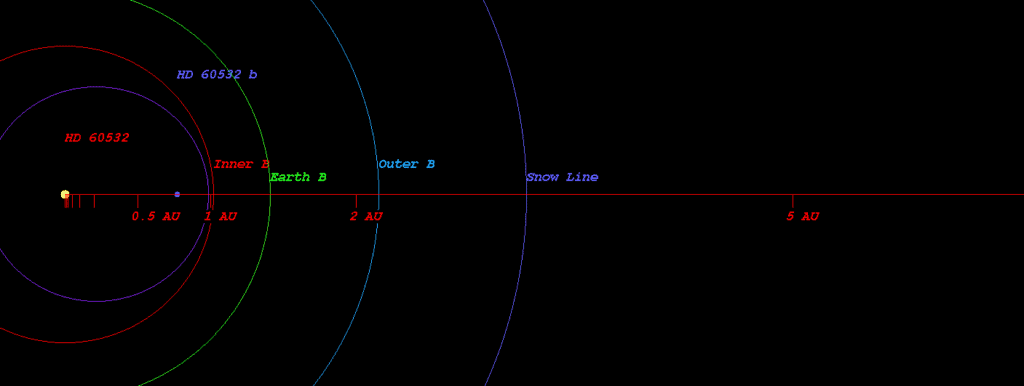
Pi Puppis
Pi Puppis, also known as Ahadi, is the second-brightest star in the constellation of Puppis. It is located at around 810 light-years away from us, and it has an apparent magnitude of 2.733.

Pi Puppis is a supergiant K-type star, having 1,170% of our Sun’s mass, 29,000% of its radius, thus it is almost 600 times bigger than our Sun, and it is 11,825 times brighter.
Tau Puppis
Tau Puppis is a spectroscopic binary star system located at around 182 light-years away from us. It has an apparent magnitude of +2.95.

The primary star of the system is a K-type giant star that has around 2,700% of our Sun’s radius, thus it is more than 50 times bigger than our Sun.
Nu Puppis
Nu Puppis is the fifth brightest star in the constellation of Puppis. It is located at around 370 light-years away from us, and it has an apparent magnitude of 3.173.

Nu Puppis is a blue-hued B-type giant star, and it is also classified as a Be shell star since it is surrounded by a circumstellar disk of heated gas.
This star is also a fast-spinning star, having a rotational velocity of 225 km / 139.8 mi per second. Because of this, the star’s equator is 31% larger than its poles, causing it to have an oblate shape.
Nu Puppis has 420% of our Sun’s radius, and it is 767 times brighter than our Sun, with its bolometric luminosity being 1,340 times greater. This star is also more than twice as hot as our Sun, with temperatures reaching 12,120 K.
HD 64760
HD 64760 is a B-type supergiant star located at around 1,660 light-years away from us. It has an apparent magnitude of 4.24.
This star is oblate since it has a rotational velocity of 238 km / 147.8 mi per second, leading to its equatorial radius to be 20% larger than its polar radius.

HD 64760 has around 1,550% of our Sun’s mass, 2,160% of its radius, and it is 155,000 times brighter than our Sun. This star is also 4.2 times hotter than our Sun, with temperatures recorded at around 24,600 K.
NS Puppis
NS Puppis is an irregular variable star. Its brightness varies from magnitude 4.4 to 4.5. This star is located at around 1,000 light-years away.
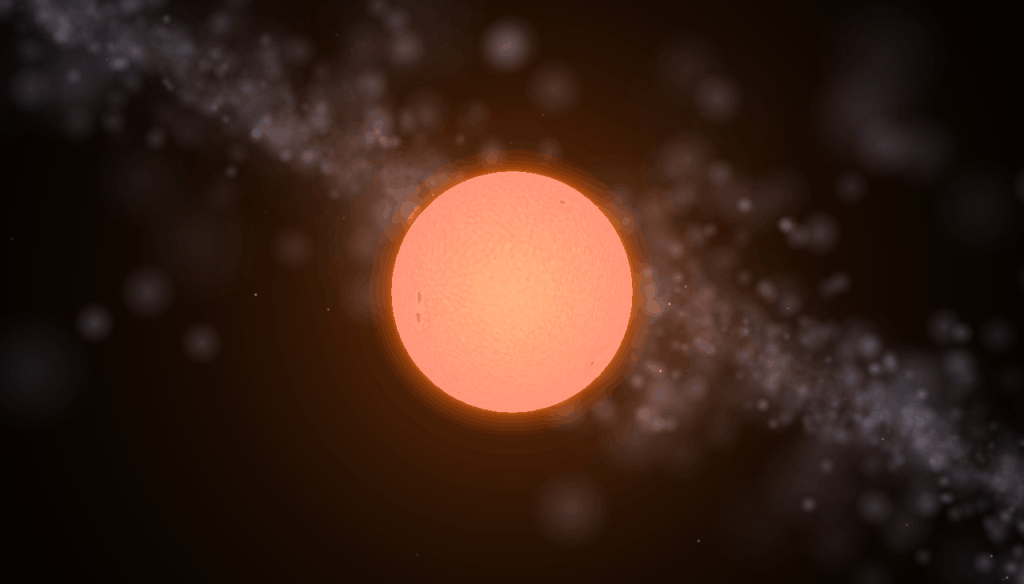
NS Puppis is a supergiant K-type star, having 970% of our Sun’s mass, 13,400% of its radius, thus it is more than 260 times bigger than our Sun, and it is also 2,290 times brighter.
L2 Puppis
L2 Puppis, also designated as HD 56096, is a giant star located at around 210 light-years away from us, between the bright star Canopus and Sirius.
L2 Puppis has an apparent magnitude of 5.10, and it is a semi-regular pulsating star, suffering in brightness variations from magnitude 2.6 to 8.

L2 Puppis is around 246 times bigger than our Sun, having only 60% of its mass, 12,300% of its radius while being around 2,000 times brighter than our Sun.
HD 68601
HD 68601 is a white supergiant star located at around 4,200 light-years away from us. It has an apparent magnitude of 4.75.
This star has around 160% of our Sun’s mass, and it is 6,310 times brighter than our Sun, and it is also hotter, having temperatures of around 7,220 K.

NGC 2423-3
NGC 2423-3 is a red giant star and a member of the NGC 2423 open cluster. It is located at around 2,498 light-years away from us, and it has an apparent magnitude of 9.45.
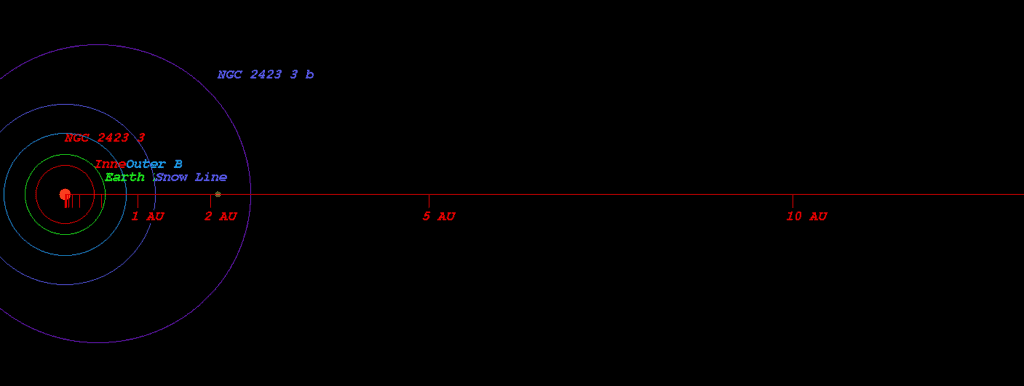
This star has around 240% of our Sun’s mass, and it also hosts an exoplanet. The exoplanet designated as NGC 2423-3 b, is 10.6 times more massive than Jupiter.
Deep-sky Objects in the Constellation of Puppis
The constellation of Puppis hosts numerous interesting deep-sky objects. It is particularly rich in open clusters, globular clusters, and nebulae since an important part of the Milky Way runs through this constellation.

Some of the most eye-catching deep-sky objects located in Puppis, apart from the aforementioned Messier objects, are the Skull and Crossbones Nebula, NGC 2451, NGC 2477, Collinder 135, NGC 2438, NGC 2509, NGC 2439, NGC 2438, NGC 2440, NGC 2298, NGC 2546, or the Calabash Nebula, among others.
The Skull and Crossbones Nebula
The Skull and Crossbones Nebula, designated as NGC 2467, is a star-forming region located at around 16,000 light-years away from us, in the constellation of Puppis.
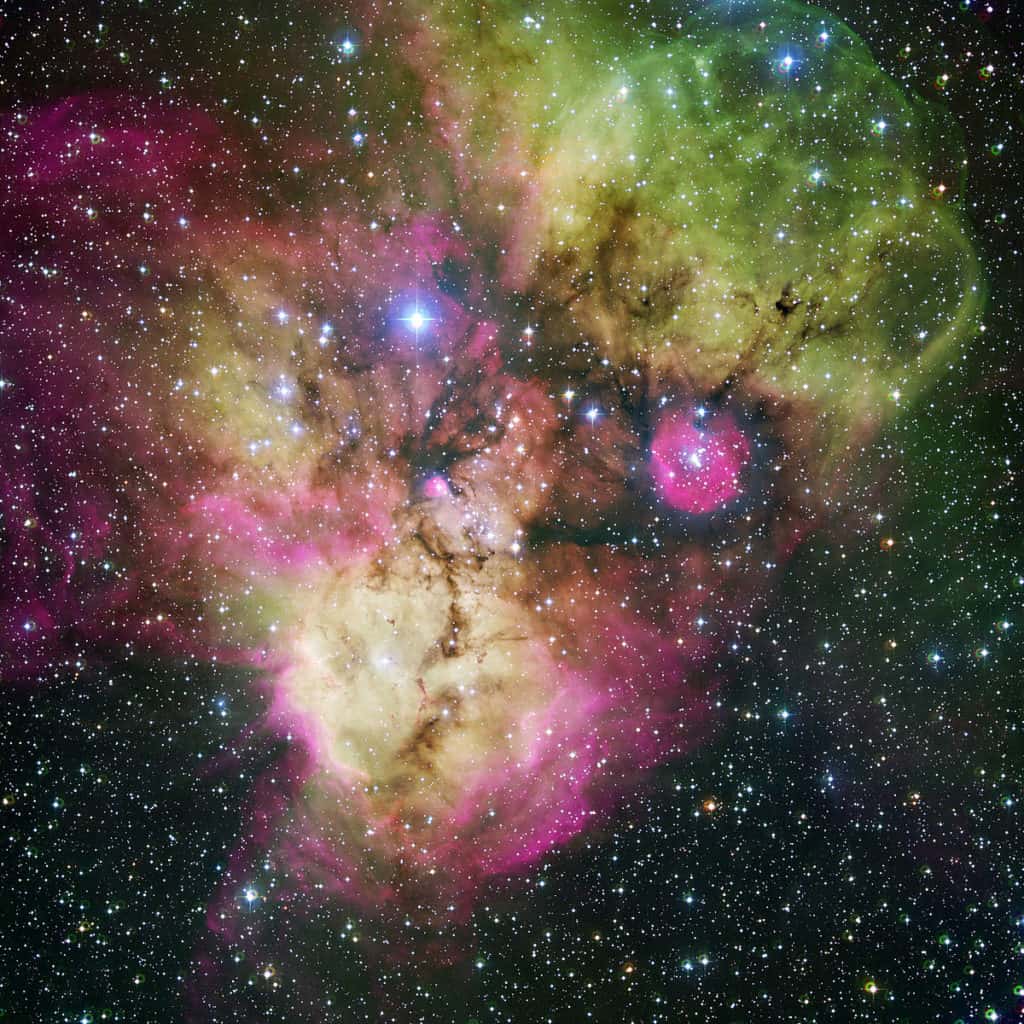
This nebula includes areas where large clouds of hydrogen gas incubate new stars. It represents a superimposition of several stellar groups.
The nebula is dominated by the massive star HD 64315, while two stellar clusters are also present within it, namely the Haffner 19, and Haffner 18.
NGC 2451
NGC 2451 is a double cluster, consisting of the open clusters NGC 2451 A and NGC 2451 B, and they are located at around 600 and 1,200 light-years respectively. This double cluster has an apparent magnitude of 3.

NGC 2477
NGC 2477, also known as Caldwell 71, is an open cluster located at around 3,600 light-years away from us. It has an apparent magnitude of 5.8, and it contains around 300 stars. It is estimated that this cluster is around 700 million years old.

Collinder 135
Collinder 135, also known as the Pi Puppis Cluster, is an open cluster located at around 1,040 light-years away from us. It has an apparent magnitude of 2.1. The main star of this cluster is the orange supergiant Pi Puppis.

NGC 2438
NGC 2438 is a planetary nebula located at around 3,000 light-years away from us. It has an apparent magnitude of +10.8, and its apparent dimension is 1.1 arcminute.
The central dead star of this nebula is a white dwarf that has a surface temperature of around 75,000 K. It is thus more than 12.9 times hotter than our Sun.

NGC 2509
NGC 2509 is an open cluster located at around 9,500 light-years away from us. It has an apparent magnitude of 9.3. This cluster is 14 light-years wide, and it is around 1.2 billion years old.

NGC 2439
NGC 2439 is an open cluster that has an angular size of 10 arcminutes. It is located at around 1,200 light-years away from us, and it has an apparent magnitude of 6.9. This cluster is 10 million years old.

NGC 2440
NGC 2440 is a planetary nebula located at around 4,000 light-years away from us. It has an apparent magnitude of 9.4. The central star is possibly the hottest known white dwarf star, reaching temperatures of around 200,000 K, being 34.6 times hotter than our Sun, and 1,100 brighter.

NGC 2298
NGC 2298 is a globular cluster, and probably a former member of the Canis Major Dwarf galaxy. It was discovered in 1826 by astronomer James Dunlop. This globular cluster has an apparent magnitude of 9.3.

NGC 2546
NGC 2546 is an open cluster that was discovered in 1751 by astronomer Abbe Lacaille. It has an apparent magnitude of 6.3.

The Calabash Nebula
The Calabash Nebula, also designated as OH 231.84 +4.22, and otherwise known as the Rotten Egg Nebula, is a protoplanetary nebula located at around 5,000 light-years away from us.
This nebula is 1.4 light-years long, and it has an apparent magnitude of 9.47. It contains large amounts of sulfur, and the densest parts of the nebula are composed of a material ejected by the central star and accelerated in opposite directions.
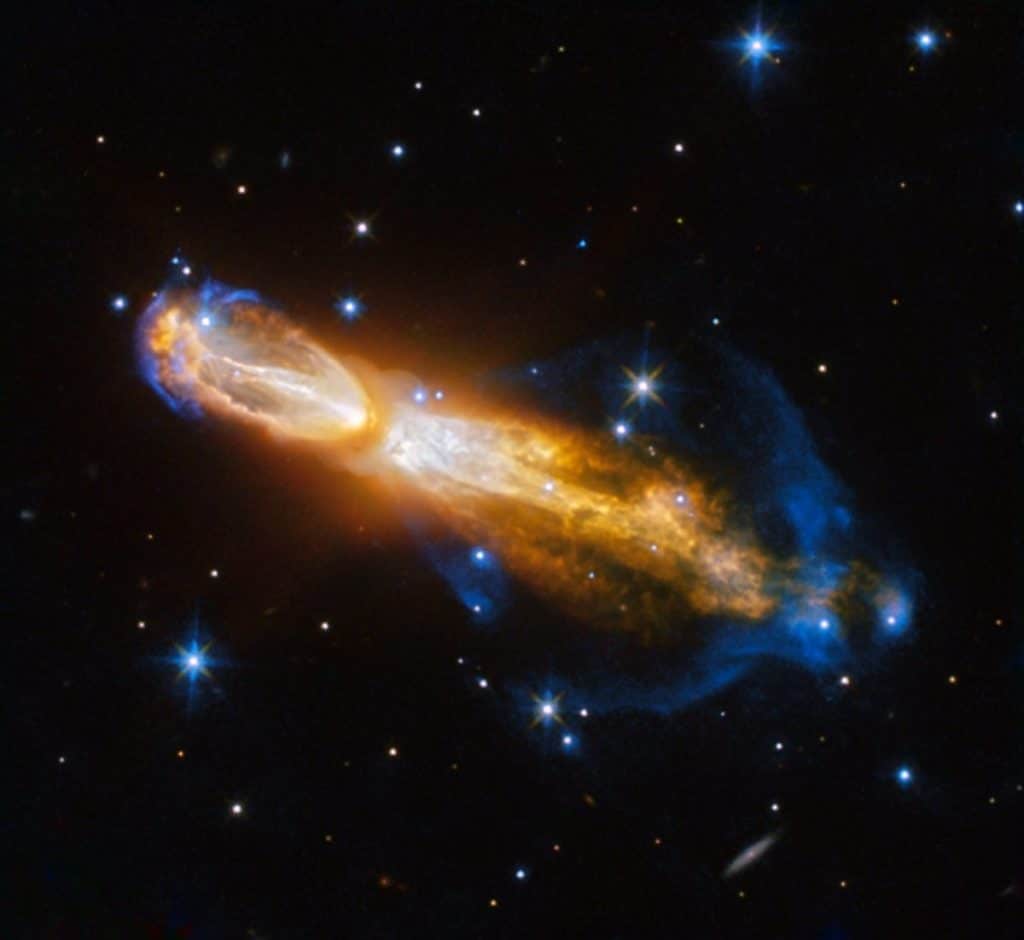
This yellow-appearing material is zooming away at speeds of up to one and a half million kilometers per hour / one million miles per hour.
Meteor Showers Associated with the Constellation of Puppis
The constellation of Puppis is associated with three meteor showers, namely the Pi Puppids, the Zeta Puppids, and the Puppid-Velids.
The Pi Puppids meteor shower occurs during April 15 and April 28, peaking on April 23. They appear to occur once every 5 years, and the parent body is believed to be the comet 26P/Grigg-Skjellerup.

The Zeta Puppids are a daylight meteor shower that takes place from May 20 to July 5, peaking on June 9 – 13. Around 40 meteor showers can be seen during the zenith. The parent body appears to be the comet 2P/Encke.
The Puppid-Velids meteor shower occurs during December 1 and 15, while peaking on December 7 each year.
Did you know?
- The constellation of Puppis and Vela doesn’t have any stars designated as Alpha or Beta, as they were allocated to the constellation of Carina.
- The brightest star in Puppis is named Naos – a name that comes from Greek, and means “ship”. Naos is also known as Suhail Hadar, an Arabic phrase that translates to “the roaring bright one”.
Sources:
Image Sources:
- https://www.peoplesguidetothecosmos.com/constellations/argo-navis-johannes-hevelius.jpg
- https://starregistration.net/media/wysiwyg/Constellations/Puppis.png
- https://in-the-sky.org/images/constellations/con_PUP_000.png
- https://www.universetoday.com/wp-content/uploads/2009/07/M46-and-M47-e1497294314505-1280×720.jpg
- https://upload.wikimedia.org/wikipedia/commons/thumb/7/75/Eso1441a.jpg/1200px-Eso1441a.jpg
- https://www.universetoday.com/wp-content/uploads/2019/12/Messier-93.jpg
- https://lh3.googleusercontent.com/proxy/LTXgwvE0lP4ztQodXg7DSFSEpUtaA20hgsyAWH4mGOGAHIDGCWl7GuU-Tv_IX3K8FakcLt4GFLmeDgobBtU8IaIHCrue
- https://upload.wikimedia.org/wikipedia/commons/f/f6/Zeta_Puppis.png
- https://lh3.googleusercontent.com/proxy/iv39vH5qqdw4KYG4z4umX4kDDQlQ2wuCmr_ZVhRkzrnNWpfDPCtW4jzhZCOcEVF6DGp6WHtyT7us_BRS-GkqCKFkSKf_Obdd2umj7kBS3DAJN7BcMmC71HsT4A
- https://www.constellation-guide.com/wp-content/uploads/2013/04/Naos-Zeta-Puppis.png
- https://lh3.googleusercontent.com/proxy/3LYA4W2CUArrxnwO7DLK5V0d5o634bVfFaX8YcoC0zgOeFVYIg5uXmH9xDT3k-OjvIH15Vfrjp7IhWtlc9wqD5jl_OslcmOAszQAnZBg4A
- https://lh3.googleusercontent.com/proxy/Ybh_CP4Ge-mGRvu7-Cx9LywBNqbI0HisiJb0C_6Xdi3WrwBhZqAzGVhBJZJztbjD2SqtcvVIDnpOsFvTIXjzJMuMHt-B
- https://upload.wikimedia.org/wikipedia/commons/5/54/HD_69830_System.jpg
- http://www.exoplanetkyoto.org/exohtml/HD_60532_b_Orb.png
- https://alchetron.com/cdn/pi-puppis-cf99d2c8-d843-45ff-8180-76e0843a001-resize-750.jpg
- https://www.constellation-guide.com/wp-content/uploads/2013/04/NGC-2451.jpg
- https://upload.wikimedia.org/wikipedia/commons/8/82/Nu_Puppis.jpg
- https://scx2.b-cdn.net/gfx/news/hires/2008/hotteststars.jpg
- https://upload.wikimedia.org/wikipedia/commons/7/7f/VX_Sagittarii_Red_Supergiant_Star.png
- https://upload.wikimedia.org/wikipedia/commons/thumb/5/56/VLT_SPHERE_and_NACO_image_of_L2_Puppis.jpg/768px-VLT_SPHERE_and_NACO_image_of_L2_Puppis.jpg
- https://upload.wikimedia.org/wikipedia/commons/thumb/c/c9/Sirius_A_and_B_artwork.jpg/640px-Sirius_A_and_B_artwork.jpg
- http://www.exoplanetkyoto.org/exohtml/NGC_2423_3_b_Orb.png
- https://upload.wikimedia.org/wikipedia/commons/thumb/4/47/A_cosmic_concoction_in_NGC_2467.jpg/787px-A_cosmic_concoction_in_NGC_2467.jpg
- https://upload.wikimedia.org/wikipedia/commons/thumb/8/84/NGC_2467_and_Surroundings.jpg/1200px-NGC_2467_and_Surroundings.jpg
- https://lh3.googleusercontent.com/proxy/bu0foqm7LvahQUhuBhlM6S2RTdCN5IyXIXHO9rUvalScS9aXztlU72q2V7WCKRudJZ3nwtnfVnrpPbC94qEQURyZ856gyNZgxk3DIN6ADRxnCuqX9_S0BXpnY7Qv_M50g-V1hwGs5Po5FC2RszXDzhYSjxA-KqRd7xIpMqD-g_HyJj_0Nu97dWhJJMKbtxgZ88LU6S7S0unCFW2Wg8A
- http://cosmicpursuits.com/wp-content/uploads/2017/02/ngc_2477-ngc_2451-1024×674.jpg
- https://upload.wikimedia.org/wikipedia/commons/3/34/Pi_Puppis_Cluster.PNG
- https://upload.wikimedia.org/wikipedia/commons/7/73/N2438s-crop.jpg
- https://upload.wikimedia.org/wikipedia/commons/7/75/NGC_2509_DSS.jpg
- https://lh3.googleusercontent.com/proxy/AwWBJy7W10TiiZuYk36u5o5mhCX9uXOALKggesYANdO5gCGxT3omhlEuBZzi5KLcNIR9QFTksx4tWwJPd5SBRQdem0RLtm_VBeXeD14xNfgvSdQ
- https://upload.wikimedia.org/wikipedia/commons/thumb/8/89/NGC_2440_by_HST.jpg/1200px-NGC_2440_by_HST.jpg
- https://upload.wikimedia.org/wikipedia/commons/thumb/9/92/NGC_2298.jpg/787px-NGC_2298.jpg
- https://upload.wikimedia.org/wikipedia/commons/1/17/NGC_2546.png
- https://upload.wikimedia.org/wikipedia/commons/thumb/d/d2/The_Calabash_clash.jpg/1200px-The_Calabash_clash.jpg
- https://strangesounds.org/wp-content/uploads/2015/04/lyrids-and-pi-puppids-meteor-showers-april-2015.jpg
